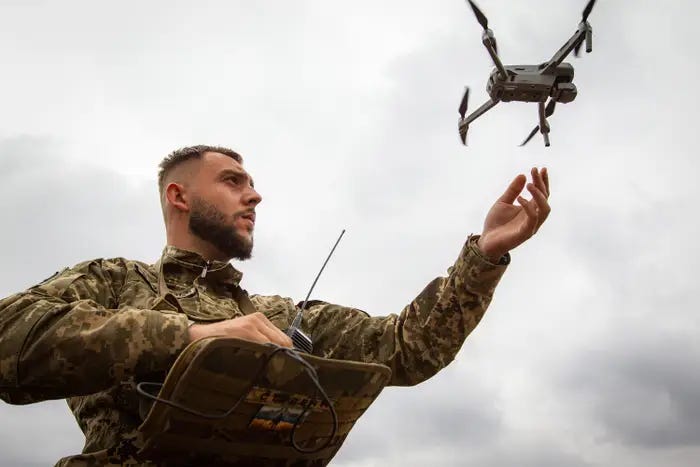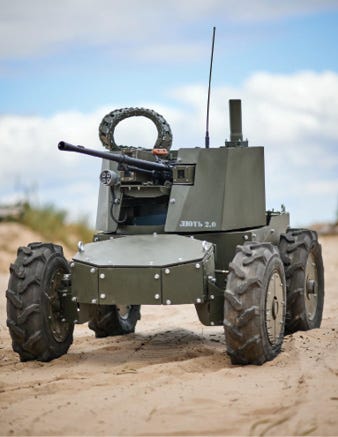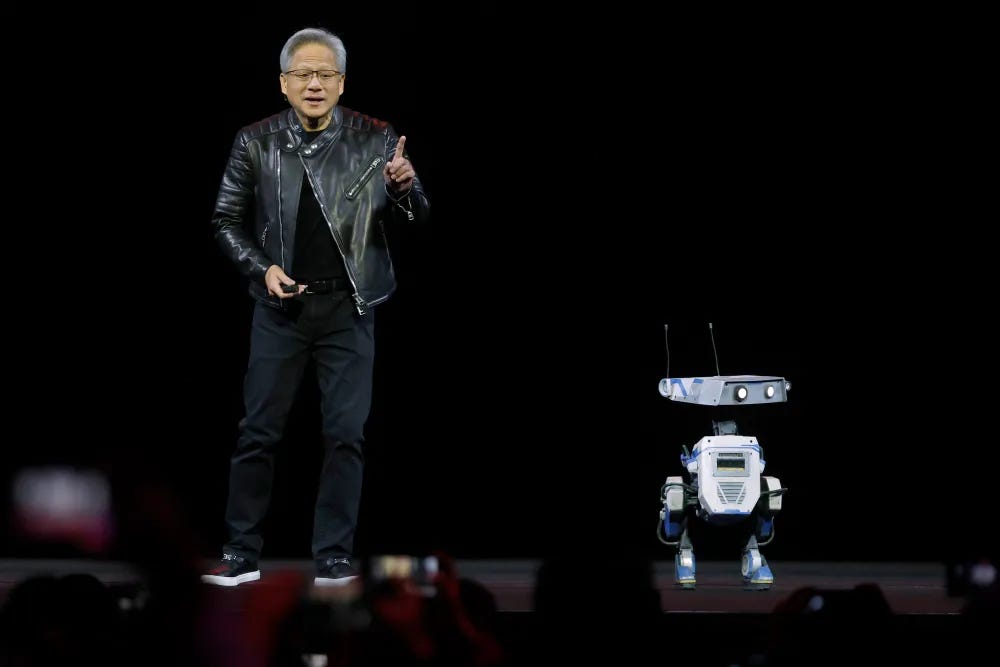The First Robot War: How the Russia-Ukraine Conflict Changed Warfare Forever
Autonomous drones, AI-driven strategy, and robotic combat have redefined the battlefield—ushering in a new era of war where machines lead the fight, and there’s no turning back.
Aaron’s Thoughts On The Week
"If you automate war, you must prepare for war at the speed of automation." – Paul Scharre, author of Army of None
The Russia-Ukraine War isn’t just another modern conflict—it’s the first war where robots, AI, and drones aren’t just assisting humans; they’re leading the attack. From the trenches to the skies, machines are dramatically changing the battlefield, from launching attacks to even fighting other machines; this conflict, regardless of your feelings about it, has forever changed warfare.
Take Ukraine’s massive drone strike in December 2023—50 unmanned aerial and ground vehicles worked together to wipe out a Russian bunker. Some drones carried explosives, some provided surveillance, and others escorted ground drones through the battlefield. It was a first-of-its-kind attack, proving that machines can spearhead assaults without human soldiers leading the charge.
But this war isn’t just about drones. AI optimizes battlefield strategy, self-driving trucks are moving supplies, and even dog-like robot scouts are being tested for future combat.
As this war continues, there is hope that a ceasefire is on the horizon. However, this conflict will be recorded in history as the first “robot” war. Even though the technology has been utilized in other conflicts, this conflict has been different because both sides are using robots and AI against each other, which does change the game. Let’s explore why this conflict deserves the title of the first “robot” war and why this represents the future of warfare, regardless of whether it is right or wrong.

Autonomous Weapons Are No Longer Experimental—They Are Essential
Before the war in Ukraine, autonomous drones and robotic systems were primarily seen as reconnaissance tools or experimental assets with limited battlefield impact. However, in this conflict, they have evolved into essential instruments of warfare, reshaping ground and aerial combat in previously thought to be futuristic ways.
Ukraine has leveraged cheap, mass-produced drones like FPV (First-Person View) models, along with Turkish-manufactured Bayraktar TB2s, to take out Russian tanks, armored vehicles, and critical infrastructure. These low-cost drones have allowed Ukraine to counter Russia’s numerical advantage, proving that affordability and scalability can outmatch sheer military might. Meanwhile, Russia has unleashed swarms of Iranian-made Shahed-136 drones, which have become a key component of its long-range strike strategy. These drones have been used to attack Ukrainian cities, energy grids, and military positions with devastating precision, further showcasing how autonomous aerial warfare has become a core strategy for both sides.

Loitering munitions, a new class of drone-based weaponry, have also emerged as game-changers. Unlike traditional missiles, loitering munitions such as Russia’s Lancet drone can hover over the battlefield, waiting for the perfect opportunity to strike. This capability makes them far more lethal than conventional guided missiles, as they can adjust to real-time changes on the battlefield before making their final attack. Ukraine, in response, has adapted by deploying its own loitering munitions and advancing counter-drone strategies that integrate AI-powered detection systems.
These developments mark a turning point in military strategy. The Russia-Ukraine War has shown that robotic warfare is no longer a side aspect of combat—it is the main battlefield. With AI-driven targeting, autonomous attack drones, and ground robots engaging in direct combat, this war has established a new precedent: the future of warfare is automated, and there is no turning back.
AI-Driven Targeting and Battlefield Automation
Unlike previous wars, where drone strikes required human operators to control targeting and execution manually, AI-powered systems are now playing an increasingly direct role in combat decision-making. This shift has accelerated the speed of warfare, allowing autonomous and semi-autonomous systems to react faster than ever before.
Ukrainian forces have integrated AI software with drone surveillance, enabling real-time battlefield analysis and automated target identification. By feeding data from multiple sources—including satellite imagery, reconnaissance drones, and radar systems—AI algorithms can identify enemy positions, prioritize high-value targets, and even suggest the best strike strategies. This level of battlefield intelligence was once limited to human analysts, but AI has vastly improved both the speed and accuracy of decision-making. Ukraine’s use of AI-assisted targeting has been a critical factor in countering Russia’s numerical advantage on the front lines.
Russia, too, has embraced AI-powered automation, particularly in its counter-drone defense systems. With Ukraine relying heavily on drone attacks, Russian forces have deployed AI-driven air defense systems that can autonomously detect, track, and neutralize incoming threats. These systems use machine learning to recognize drone flight patterns and optimize interception strategies without direct human intervention. The effectiveness of these AI-powered defenses has forced Ukraine to constantly evolve its tactics, showcasing how AI is driving a technological arms race in real-time.
This level of automation has drastically reduced the time between target identification and destruction, a crucial factor in modern warfare where mere seconds can mean the difference between survival and defeat. AI’s role in combat is no longer experimental—it is a battlefield necessity. Unlike previous conflicts, where automation played a supporting role, the Russia-Ukraine war has demonstrated that AI is now an essential combatant in its own right, fundamentally altering military strategy and engagement.
The December 2023 Attack That Changed The World
In December 2023, Ukrainian forces launched a historic attack near Kharkiv, deploying 50 unmanned aerial and land vehicles in a coordinated assault on a Russian bunker. The operation was a proof of concept for large-scale robotic warfare, demonstrating the potential of drones and autonomous systems working in unison on the battlefield. Unlike previous drone-based attacks, which relied mainly on aerial strikes, this mission integrated land-based unmanned vehicles (UGVs) armed with machine guns and explosives, supported by aerial drones for reconnaissance and firepower. It was a glimpse into the future of combat, where machines take the lead in frontline engagements.
The attack required extensive planning, with operators rehearsing three times to fine-tune signal coordination and prevent drones from interfering with each other. Each drone’s path was meticulously mapped to ensure smooth execution. As the assault began, ground drones were deployed from multiple locations, some miles away from the front line, to avoid signal overlap. These land drones, equipped with cameras and weapons, relied on aerial drones for signal amplification and real-time reconnaissance, creating a fully integrated, machine-led offensive. The effectiveness of swarm coordination in this battle highlights the increasing sophistication of unmanned combat operations.
Despite its success, the mission also exposed challenges that will shape the next phase of drone warfare. Mud proved to be a formidable adversary for land drones, causing some to become bogged down and disrupting their movement. The difficulties faced by these unmanned vehicles prompted immediate modifications, particularly in their suspension systems, to improve performance in rough terrain. This battle served as a learning experience, accelerating the refinement of Ukraine’s ground-based drone technology. The rapid evolution of robotic warfare, driven by real-world combat conditions, underscores why this war is a testing ground for the future of autonomous military operations.
Ground Robots Are Fighting on the Frontlines
For the first time in history, unmanned ground vehicles (UGVs) are not just assisting troops but actively engaging in battlefield operations. In the Russia-Ukraine War, robotic combat vehicles have transitioned from experimental concepts to frontline assets, reshaping how wars are fought. Unlike past conflicts, where ground robots were mainly used for bomb disposal or reconnaissance, today’s UGVs are carrying out logistics, launching attacks, and even engaging enemy forces autonomously.
Ukraine has integrated UGVs like THeMIS and other robotic combat vehicles (RCVs) into its operations, using them for tasks ranging from resupply missions and casualty evacuation to carrying mounted machine guns into combat. These robotic systems have been essential in reducing human exposure to danger, allowing soldiers to operate from safer distances while still maintaining an aggressive battlefield presence. THeMIS, for example, has been deployed to deliver ammunition and evacuate wounded soldiers under fire, tasks that would otherwise be life-threatening for human troops.
Russia, too, has embraced autonomous ground warfare with its Marker UGV, a robotic platform equipped with AI-driven targeting capabilities. Unlike traditional remote-controlled systems, the Marker has demonstrated the ability to independently identify and engage enemy targets. Designed with advanced machine-learning algorithms, it can assess threats in real-time and react without direct human input, making it one of the most advanced autonomous combat robots deployed in any war to date. The potential of such autonomous weapons is both groundbreaking and concerning, raising new ethical and strategic questions about the role of AI in lethal force decision-making.
As robotic combat systems continue to evolve, Ukraine and Russia are rapidly adapting to a new era of warfare in which machines take on increasingly complex roles. Whether used for logistics, direct assaults, or defensive operations, these UGVs are proving that ground combat is no longer solely a human domain. The Russia-Ukraine War has set a precedent that future conflicts will almost certainly follow, ushering in an age where robots fight alongside—or even in place of—soldiers.
This Changes Everything
The Russia-Ukraine War has shattered traditional military doctrine, proving that humans no longer need to lead the charge into battle. The December 2023 drone assault near Kharkiv was a defining moment, showcasing that warfare can now begin with machines taking the first wave of fire. In that attack, Ukrainian forces unleashed 50 drones—both aerial and land-based—to strike a Russian bunker. FPV drones, armed with explosives, maneuvered through enemy defenses, while armed ground drones rolled forward under the cover of aerial surveillance. This new approach minimized human casualties while maximizing battlefield effectiveness, marking a dramatic shift in how wars are fought.
But it wasn’t just drones attacking human targets. For the first time, unmanned systems fought each other in real-time. As Ukrainian land drones advanced, Russian FPV drones responded, leading to head-on drone battles in the middle of combat. This wasn’t science fiction—it was a battlefield reality. Warfare is no longer just about outmaneuvering human opponents; now, militaries must also outthink the machines they’re up against. Drone-on-drone combat is just the beginning, signaling a future where AI-controlled warfare will continue to evolve at an unprecedented rate.
Beyond combat, AI is revolutionizing warfare logistics. Ukraine has already begun using self-driving trucks to transport ammunition and medical supplies, reducing the need for human drivers on dangerous roads. AI-powered software is now analyzing battlefield data in real time, predicting Russian movements, and allowing Ukrainian forces to adjust strategies before an attack even happens. This level of automation and battlefield intelligence was unheard of in previous conflicts, but today, it’s becoming a necessity. As technology advances, military strategy will shift even further away from traditional human-led operations.
The lessons from this war are clear: the future of combat will be dominated by autonomous weapons, AI-driven decision-making, and robotic warfare on a scale never seen before. The Russia-Ukraine War has been a proving ground for these technologies, making it the first true robot war. Drones and AI-driven weapons are no longer experimental—they are essential. Autonomous systems will continue to evolve, increasing warfare's speed, precision, and lethality. Future conflicts will be fought with even greater reliance on automation, and nations that fail to adapt will find themselves at a strategic disadvantage.
While humans will still play a role in decision-making, the battlefield itself is becoming increasingly robotic. The Russia-Ukraine War has proven that AI and automation aren’t just the future of warfare—they are warfare. Militaries around the world are watching closely, analyzing how these technologies are shaping the battlefield, and preparing for what’s next. This war has fundamentally changed military strategy, and there is no going back.
The age of robotic warfare isn’t coming. It’s already here.
Robot News Of The Week
Apptronik brings in another $53 million to fuel Apollo production
Apptronik has added $53 million to its oversubscribed Series A round, raising a total of $403 million. The funding will accelerate production and deployment of its AI-powered humanoid robot, Apollo, and support growing demand across industries like automotive, logistics, and electronics manufacturing.
The company has secured agreements with Mercedes-Benz and GXO Logistics for real-world testing. CEO Jeff Cardenas emphasized the goal of integrating humanoid robots into logistics, manufacturing, and eventually healthcare and disaster response.
This follows a year of growth, including a partnership with Google DeepMind and a collaboration with Jabil to manufacture Apollo. Investors in the round include B Capital, Google, Mercedes-Benz, Japan Post Capital, ARK Invest, and others.
The humanoid robotics sector is booming, with Figure AI raising $854M, Agility Robotics securing $178M+, and 1X Technologies raising $136.5M.
Nvidia Teams With Disney on AI Robotics Project: ‘The Age of Generalist Robotics Is Here’
Nvidia unveiled new initiatives to accelerate humanoid robot development, including Newton, an open-source physics engine created in collaboration with Disney Research and Google DeepMind. Disney plans to use Newton to enhance its next-generation entertainment robots, such as the Star Wars-inspired BDX droids. Nvidia also introduced Isaac GR00T N1, the first customizable AI model designed for humanoid reasoning and skills, now accessible to robotics developers. During Nvidia’s GTC 2025 keynote, CEO Jensen Huang showcased a humanoid robot performing domestic tasks using GR00T N1, emphasizing its potential for autonomous, multistep actions. Early adopters include Agility Robotics, Boston Dynamics, and Neura Robotics.
Kroger pilots autonomous inventory scanning robots
Kroger is testing autonomous aisle-scanning robots from two companies in select stores.
The grocer is piloting Tally from Simbe Robotics in 35 Indianapolis stores and four in Cincinnati, starting in late 2024. Additionally, Kroger is testing robots from Badger Technologies, in other locations. In total, 70 stores across Cincinnati and Indianapolis are part of these pilots.
Kroger began testing these robots to gain real-time inventory insights, helping workers quickly address low-stock or out-of-stock items. The move aligns with a broader industry trend of using automation to streamline operations.
Simbe’s Tally is already in use at retailers like BJ’s Wholesale and SpartanNash, while Badger Technologies’ robots are deployed at Woodman’s Markets and Stop & Shop, where they are nicknamed “Marty.”
Kroger and Badger Technologies have not commented on the pilot.
Robot Research In The News
Legged robots skateboard successfully with reinforcement learning framework
Researchers have developed a reinforcement learning-based framework that enables legged robots to skateboard. Created by the University of Michigan's CURLY Lab and Southern University of Science and Technology, the DHAL (Discrete-Time Hybrid Automata Learning) system assists robots in performing contact-guided motions. Unlike conventional methods, DHAL autonomously identifies sudden transitions in movement, allowing robots to step onto smoothly and ride skateboards while towing objects. This breakthrough could enhance robot mobility in urban deliveries and industrial applications. Future plans include expanding DHAL to include dexterous object manipulation, improving robots' ability to interact with their environment.
A squirrel-inspired robot that can leap from limb to limb
UC Berkeley researchers have developed a hopping robot inspired by squirrels, capable of landing on narrow perches. Using insights from squirrel biomechanics, they modified the Salto robot to adjust its posture mid-air for precise landings. The breakthrough, published in Science Robotics, could improve robotic agility for tasks like navigating construction sites or monitoring forests. Researchers also explore using one-legged robots for space exploration, such as hopping across Saturn’s moon, Enceladus. Future work aims to enhance robot gripping for better control, expanding their ability to land on various surfaces and navigate complex environments.
Robot Workforce Story Of The Week
A pair of sisters have launched a robotics program for elementary students.
Robot Video Of The Week
Boston Dynamics’ Atlas 2.0 humanoid robot can now breakdance. Due to its swiveling joints and superior range of motion, this iteration performs complex movements like running, jumping, and fine manipulation. Notable breakdancing moves include bending its legs backward, rising from a prone position, and rotating its head and torso 180 degrees. It learns through reinforcement learning and foundation models to adapt to complex environments, such as reaching into cluttered containers and navigating obstacles, while ensuring high reliability.
Upcoming Robot Events
Mar. 21-23 Intl. Conference on Robotics and Intelligent Technology (Macau)
Mar. 25-27 European Robotics Forum (Stuttgart)
Apr. 23-26 RoboSoft (Lausanne, Switzerland)
Apr. 30-May 1 Robotics Summit (Boston, MA)
May 12-15 Automate (Detroit, MI)
May 17-23 ICRA 2025 (Atlanta, GA)
May 18-21 Intl. Electric Machines and Drives Conference (Houston, TX)
May 20-21 Robotics & Automation Conference (Tel Aviv)
May 29-30 Humanoid Summit - London
June 30-July 2 International Conference on Ubiquitous Robots (College Station, TX)
Aug. 18-22 Intl. Conference on Automation Science & Engineering (Anaheim, CA)
Oct. 6-10 Intl. Conference on Advanced Manufacturing (Las Vegas, NV)
Oct. 15-16 RoboBusiness (Santa Clara, CA)
Oct. 19-25 IEEE IROS (Hangzhou, China)
Nov. 3-5 Intl. Robot Safety Conference (Houston, TX)
Dec. 11-12 Humanoid Summit (Silicon Valley TBA)










